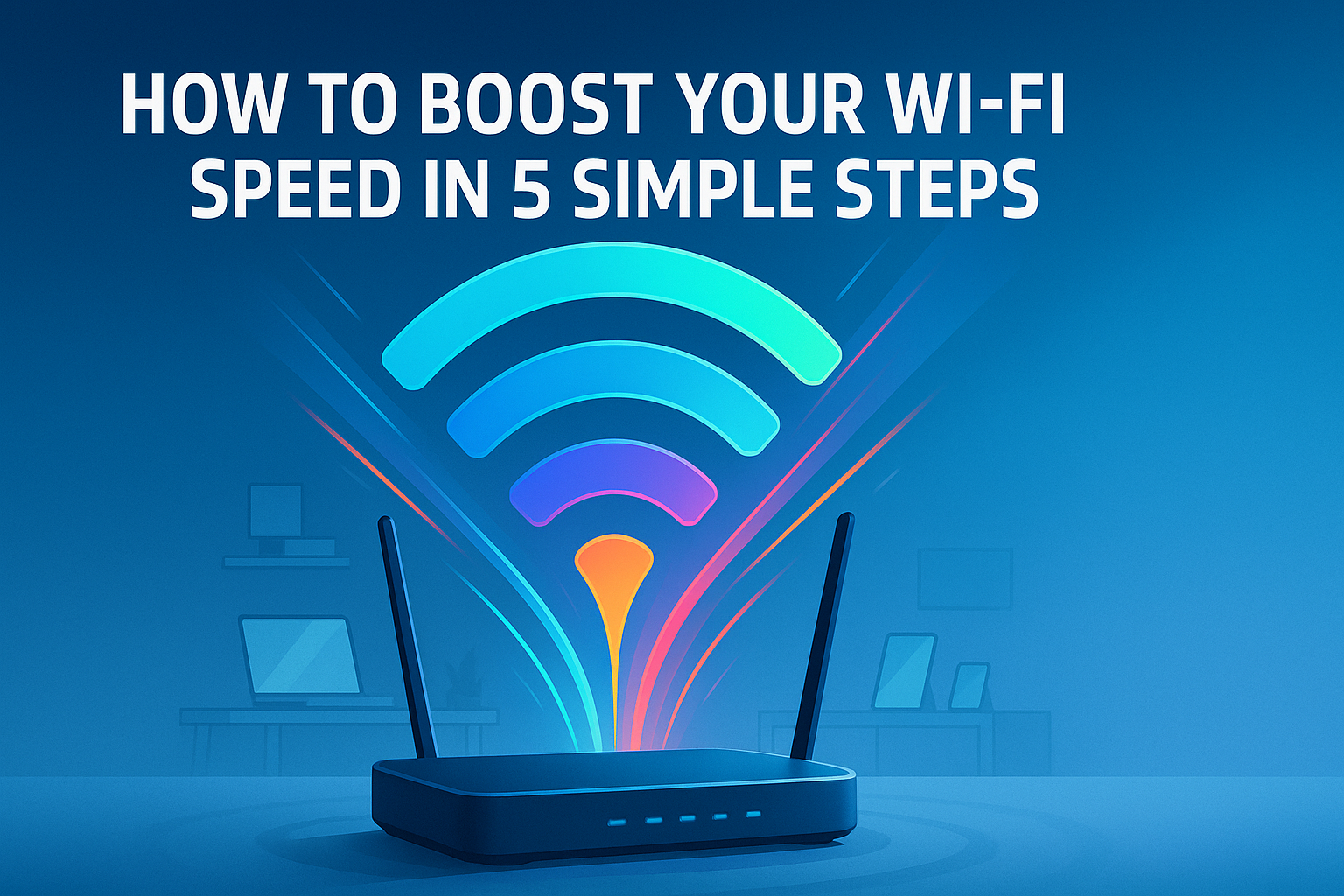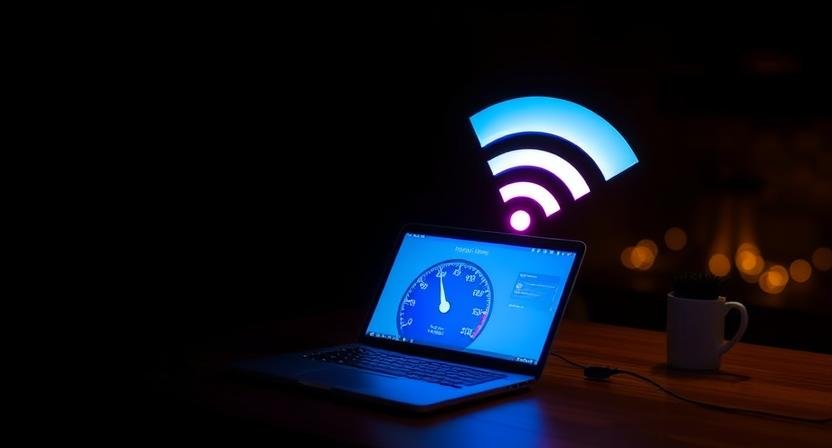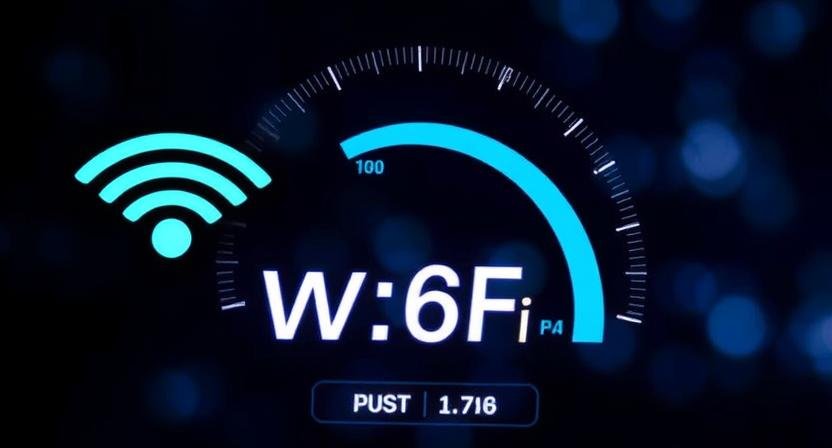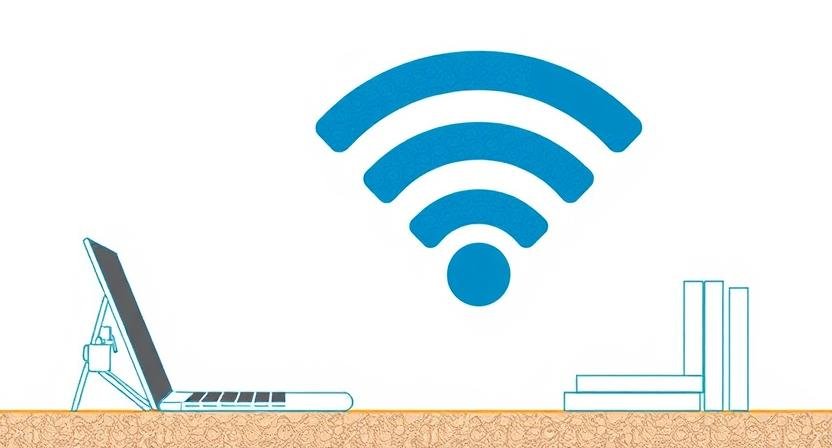Physical Address
304 North Cardinal St.
Dorchester Center, MA 02124
Physical Address
304 North Cardinal St.
Dorchester Center, MA 02124

Ever stared at that frustrating buffering icon during an important video call? Or watched as downloads crawl along at a snail’s pace? The average household now has 11 connected devices fighting for bandwidth, and that number keeps climbing. It’s no wonder so many are looking for ways to boost your Wi-Fi speed.
This guide cuts through the technical jargon to deliver real solutions that help you boost your Wi-Fi speed without calling in expensive professionals. Whether you’re streaming, gaming, or working remotely, you’ll find actionable steps to finally boost your Wi-Fi speed and eliminate dead zones.
Slow internet isn’t just annoying—it’s productivity theft. With more people working remotely, a strong Wi-Fi signal has become as essential as electricity. The good news? You can boost your Wi-Fi speed without purchasing a new router or upgrading service plans.
What’s really causing that digital traffic jam in your home might surprise you. And the first step to boost your Wi-Fi speed is hiding in plain sight. (The Future of Digital Life)

Ever wondered why your neighbor streams 4K movies without buffering while you can’t even load a simple webpage? The difference might be your WiFi plan.
Most homes settle for whatever internet package the first salesperson offered them. Big mistake! Your WiFi plan is the foundation of your internet experience.
Think of it like this: You wouldn’t put regular gas in a sports car, right? So why handicap your smart home with a basic internet plan?
Here’s what to look for:
Not all providers are created equal. Some offer blazing speeds but terrible customer service. Others are reliable but overpriced.
Pro tip: Run an internet speed test during peak hours (7-10 PM) to see what you’re actually getting. If it’s consistently below 70% of what you’re paying for, it’s time to call your provider or shop around.
Remember: The best WiFi optimization starts with the right plan. Everything else is just fine-tuning.

Ever wondered why your WiFi works great in your living room but tanks when you go to the bathroom? Physical barriers are likely the culprit. Walls, especially those made of concrete or brick, absolutely destroy WiFi signals. Metal objects, large mirrors, and even fish tanks can bounce or block your signal.
Your neighbor’s WiFi network could also be crashing your party. If you’re both using the same channel, you’re essentially shouting over each other. That microwave heating up your leftovers? It’s a WiFi killer when running. Same goes for baby monitors and cordless phones.
That router you bought five years ago? It’s ancient in tech years. Older routers simply can’t handle the speeds modern ISPs offer. It’s like trying to drink from a fire hose through a coffee straw.
Not all gadgets are created equal. Your shiny new laptop might support WiFi 6, but your smart thermostat from 2015 is still limping along on older standards. These slower devices can drag down your entire network’s performance.
Router software needs updates just like your phone. Manufacturers regularly release firmware updates to fix bugs and improve performance. Skipping these is like never changing your car’s oil—eventually, things break down.
If your internet suddenly slows to a crawl, uninvited digital guests might be hogging your bandwidth. Malware can use your connection to send spam, mine cryptocurrency, or worse. This secret background activity steals your speed without you even knowing it — so staying secure is a key way to boost your Wi-Fi speed.

Tired of your Wi-Fi crawling at snail speed? Sometimes the smartest way to boost your Wi-Fi speed isn’t by tweaking your current setup but by switching providers altogether.
Astound Broadband has earned its spot as the #1 cable ISP for good reasons. When you’re battling constant buffering and frustrating disconnections, upgrading to a provider that delivers consistent performance can boost your Wi-Fi speed dramatically.
What makes Astound stand out? Their fiber-optic network delivers speeds up to 10 Gbps in many areas — that’s up to 100x faster than standard cable. No more waiting for Netflix to load or watching your Zoom calls freeze during important meetings. If you’re ready to boost your Wi-Fi speed, switching to a high-performance provider like Astound could be the game-changer.
Their customer satisfaction ratings tell the story:
| Category | Astound Rating | Industry Average |
|---|---|---|
| Speed consistency | 96% | 78% |
| Uptime guarantee | 99.9% | 97% |
| Customer support | 4.7/5 | 3.2/5 |
Beyond raw speed, Astound offers optimized home networking solutions that help boost your Wi-Fi speed even further. Their newest Wi-Fi 6 routers provide better signal distribution, reduced interference, and can handle more connected devices simultaneously — all key factors that boost your Wi-Fi speed and improve your overall internet experience.
The best part? New customers often qualify for promotional rates that make superior internet surprisingly affordable. Many households discover they’re actually paying less for significantly better performance — a smart way to boost your Wi-Fi speed without breaking the bank.
Don’t just troubleshoot your slow connection – upgrade it completely.

Your internet speed is the foundation of your Wi-Fi experience. Think of it as the water main that feeds all the faucets in your house – if the main pipe is narrow, no fancy showerhead will give you better pressure.
Before blaming your router, you need to know what you’re actually getting from your Internet Service Provider (ISP). Run a quick speed test using sites like Speedtest.net or Fast.com. For accurate results:
Getting frustrated with buffering videos and laggy video calls? Your current internet plan might simply be too slow for what you’re trying to do.
Here’s what different activities typically require:
| Activity | Minimum Speed | Recommended Speed |
|---|---|---|
| Basic browsing | 3 Mbps | 5-10 Mbps |
| HD video streaming | 5 Mbps | 10+ Mbps |
| 4K streaming | 25 Mbps | 35+ Mbps |
| Online gaming | 3-6 Mbps | 15-25 Mbps |
| Video calls | 1-4 Mbps | 5-10 Mbps |
| Multiple users | 25+ Mbps | 50-100+ Mbps |
Remember, these speeds get divided among all connected devices. A 25 Mbps connection shared among five devices means each might only get about 5 Mbps – barely enough for HD streaming on one device, let alone multiple.

Struggling with slow internet? Your router’s location might be the culprit. WiFi signals hate obstacles – walls, furniture, and appliances all weaken your connection.
Think of your router as the sun in your home network solar system. It needs to be central and elevated. Tucked away in a basement corner? That’s asking for trouble.
Here’s what to do:
Got a large home? Those far corners might need a WiFi extender or mesh network to get the boost wifi speed you’re after.
When was the last time you restarted your router? This simple fix solves more internet problems than you’d think.
Power cycling clears your router’s cache, flushes out memory issues, and reestablishes connections with your ISP. It’s like giving your equipment a mini vacation.
The proper way to power cycle:
Do this monthly to improve home network performance and prevent slowdowns before they happen.
That neighbor secretly using your WiFi? They’re stealing more than internet – they’re stealing your speed.
Unsecured networks invite bandwidth thieves and potential security threats. Protecting your network isn’t just smart security – it’s a wifi optimization strategy.
Take these steps now:
After securing your network, run an internet speed test to see the difference. You’ll likely notice the improvement immediately when those unwanted users get kicked off your network.

Before you start tweaking your Wi-Fi setup, you need a baseline. Running a speed test is like checking your vital signs before starting a fitness program.
Head over to speedtest.net or fast.com and run a quick test. But here’s the trick – don’t just test once. Run tests at different times of the day to get the real picture.
Morning speeds might be great, but what about during those evening Netflix hours when everyone’s online?
Got your numbers? Now let’s make sense of them:
| Speed Range | What It Means For You |
|---|---|
| Under 10 Mbps | Barely enough for basic browsing |
| 10-25 Mbps | OK for one person, struggles with HD streaming |
| 25-50 Mbps | Decent for a small household |
| 50-100 Mbps | Solid performance for multiple users |
| 100+ Mbps | Great for heavy streaming and gaming |
Dig out your internet bill or log into your account. What speed are you actually paying for?
If you’re getting 25 Mbps but paying for 100 Mbps, you’ve got a problem to solve. But if you’re getting 45 Mbps on a 50 Mbps plan, your router might be working just fine – you just need a better plan for your needs.
Don’t waste time fixing what isn’t broken. Knowing your actual speeds helps target your efforts where they’ll make a difference.
Ever ran a speed test and wondered if your internet is actually slow or you’re just being picky? Truth is, most folks don’t know what speed they actually need.
For basic browsing and email checking, 25 Mbps works fine. But if you’re streaming Netflix in 4K while your kids are gaming and your partner’s on a Zoom call? You’ll need at least 100 Mbps to keep everyone happy.
Here’s a quick breakdown:
| Activity | Recommended Speed |
|---|---|
| Basic browsing | 5-10 Mbps |
| HD streaming | 25 Mbps |
| 4K streaming | 35+ Mbps |
| Online gaming | 15-25 Mbps |
| Multiple users | 100+ Mbps |
| Work from home | 50+ Mbps |
Your ISP might be holding you back. Many providers offer better plans than what you currently have, sometimes at competitive prices.
Call your provider and ask about current promotions. Often, you can bump up your speed for just $10-15 more monthly. And don’t be shy about mentioning competitor offers—this often triggers “special” discounts.
WiFi standards matter way more than most people realize. If you’re still using an older router with 802.11n (WiFi 4), you’re leaving serious speed on the table.
The newer standards give you massive improvements:
That router your ISP gave you three years ago? It’s probably garbage. Most provider-supplied equipment is basic at best.
Investing in a quality router ($100-200) can dramatically boost your wifi speed and coverage. Look for WiFi 6 compatibility, dual or tri-band capabilities, and MU-MIMO technology for handling multiple devices simultaneously.

Gaming needs serious internet juice. You know that frustrating lag right when you’re about to make the winning move? Yeah, that’s slow Wi-Fi ruining your game.
Most gamers don’t realize their router settings are killing their performance. Head into your router’s admin panel and prioritize gaming traffic. See if QoS (Quality of Service) options are available – this lets you tell your router “hey, these gaming devices come first.”
Some routers have gaming modes built right in. Enable that and watch your ping times drop.
Truth bomb: nothing beats a wired connection for gaming. Check this out:
| Connection | Average Ping | Stability | Best For |
|---|---|---|---|
| Ethernet | 5-20ms | Rock solid | Competitive gaming |
| 5GHz Wi-Fi | 15-35ms | Good | Casual gaming |
| 2.4GHz Wi-Fi | 30-60ms | Variable | Not recommended |
If running a cable isn’t possible, get your console or PC as close to the router as you can. Gaming from three rooms away? That’s asking for trouble.
Put your router in the same room as your gaming setup. Sounds obvious, but you’d be shocked how many people stick their router in some closet and wonder why they’re lagging.

Gaming demands the best from your Wi-Fi, and outdated firmware is like running a race with weights on. Most gamers don’t realize their router might be running software from two years ago. Seriously, when was the last time you checked?
Updating your router’s firmware takes 5 minutes but can dramatically boost your wifi speed. Manufacturers regularly patch security holes and optimize performance. These updates often improve how your router handles multiple devices—exactly what you need when everyone’s streaming Netflix while you’re trying to win that crucial match.
To update:
Pro tip: Set a quarterly reminder to check for updates. Your gaming sessions will thank you.
Dead zones killing your gaming vibe? WiFi extenders are game-changers for larger homes or apartments with connectivity black holes.
Think of extenders as relay runners passing your internet signal across your home. For gaming, look for dual-band extenders that support 5GHz—they’ll give you the speed needed for those split-second decisions.
When shopping for an extender, prioritize these features:
Place your extender halfway between your router and your gaming station for optimal signal strength. A well-positioned extender can boost your connection by 50% or more, eliminating those rage-inducing lag spikes.

Got slow WiFi dragging you down? Been there. The good news? You don’t need a computer science degree to fix it.
Start with a simple internet speed test. Sites like Speedtest.net or Fast.com give you the real numbers in seconds. Run these tests at different times of day to spot patterns.
Next, take a hard look at your router placement. That thing hiding in a cabinet? Big mistake. Your router needs space to breathe—central location, elevated position, away from walls and metal objects.
Check what’s hogging your bandwidth too. Netflix in 4K while someone’s gaming and another person’s on a video call? That’s your problem right there. Consider setting up device priorities through your router’s Quality of Service (QoS) settings.
Don’t ignore those router updates either. Manufacturers release firmware updates that can significantly boost your wifi speed without costing you a dime.
For many homes, the solution might be a mesh network system. Unlike traditional extenders, mesh systems create a seamless blanket of coverage throughout your home.
And hey, sometimes the truth hurts—your internet plan might just be too slow for your needs. Compare providers in your area. Many offer promotional rates for new customers, and a simple call threatening to switch can sometimes score you a better deal.
Want to fix your sluggish WiFi without calling tech support? I’ve got some quick fixes that actually work.
First, your router placement matters more than you think. Don’t hide it in a cabinet or behind furniture. Put it in a central location, away from walls and metal objects that block signals. Elevate it if possible – WiFi signals spread downward, so higher is better.
Those dead zones in your home? Try mesh WiFi systems or a simple WiFi extender. They work wonders for larger homes where your main router just can’t reach every corner.
Too many devices hogging your bandwidth? Yeah, that’ll slow things down fast. Disconnect devices you’re not using, and consider upgrading to a dual-band or tri-band router that can handle multiple connections better.
The eternal debate! Here’s the honest truth about both options:
| Connection Type | Pros | Cons |
|---|---|---|
| Wired (Ethernet) | Faster speeds, more reliable, less interference | Limited mobility, requires cables throughout house |
| Wireless (WiFi) | Convenient, no cables, supports mobile devices | More interference, slower than wired, security concerns |
If you need rock-solid connection for gaming or video calls, nothing beats a wired connection. But for everyday browsing and streaming, modern WiFi is perfectly fine if set up correctly.
An unsecured network isn’t just a privacy risk—it can seriously drag down your performance when neighbors “borrow” your connection. Want to boost your Wi-Fi speed? Start with better security.
Change that default password immediately! Use WPA3 encryption if your router supports it, or at least WPA2. Those older security protocols (like WEP) might as well be an open door.
Is your network name still “Netgear123” or “Linksys”? That’s basically advertising your router type to hackers. Rename it to something unique, but steer clear of personal info.
Lastly, check who’s connected to your network regularly. Most router apps show all connected devices—making it easy to spot and remove uninvited guests who may be slowing you down.
You’re staring at your bill, seeing you pay for 300 Mbps, but your speed test shows 45 Mbps. Frustrating, right?
Several culprits could be stealing your speed:
Want better WiFi without calling your provider? Try these quick fixes:
The short answer? Maybe.
If your current router is:
Then yes, upgrading could dramatically improve your speeds.
A new router won’t increase the speed coming from your ISP, but it will help your devices use more of what you’re already paying for. Think of it like replacing a clogged pipe – the water supply stays the same, but more water gets through.
Modern routers with WiFi 6 support and mesh systems can double or triple your effective speeds in larger homes.
You probably need more speed if:
Before upgrading:
Sometimes the issue isn’t your plan but how efficiently you’re using it. If you’ve optimized everything and still struggle, then it’s time to call your provider about faster options.
Ever wonder why your Wi-Fi is blazing fast in one room but crawls in another? Boost your Wi-Fi speed by rethinking your router placement — it’s more important than you think.
For maximum coverage, put your router in a central location — not stuffed in a cabinet or basement. Keep it elevated (on a shelf or desk) and away from thick walls, metal objects, and other electronics that can block signals.
Another pro tip to boost your Wi-Fi speed: avoid placing your router near windows. That sends precious signal strength outside your home where you can’t use it. And those kitchen appliances? They’re signal killers. Microwaves, refrigerators, and even baby monitors can create serious interference.
Security isn’t something you set and forget. In 2025, hackers are smarter than ever, but these steps will lock down your network:
Consider setting up a VPN at the router level for an extra security blanket that protects every device on your network.
Tired of dead zones? Mesh networks are your answer. Unlike traditional extenders, mesh systems create a seamless blanket of coverage throughout your home.
Setting one up is surprisingly simple:
Most systems handle the complicated stuff automatically, finding the best channels and routing traffic efficiently.
| Feature | Mesh System | Traditional Router |
|---|---|---|
| Coverage | Multiple units for whole-home coverage | Single unit with limited range |
| Setup | Simple app-based setup | Often complex web interfaces |
| Seamless roaming | Yes – one network name | No – manual switching between networks |
| Price | $$$ (typically $200-$500) | $ ($50-$200) |
| Best for | Larger homes, multiple floors | Smaller apartments, single floor |
The biggest difference? Mesh systems eliminate the frustrating network drops when moving around your home.
Internet outages always happen at the worst possible time. That’s where eero Internet Backup shines.
This clever feature automatically switches to a cellular connection when your main internet goes down. No configuration needed – it happens instantly in the background. You can keep working, streaming, or gaming without missing a beat.
The system prioritizes essential devices during backup mode, so your work laptop gets bandwidth before less important gadgets. This intelligent traffic management helps boost your Wi-Fi speed where it matters most, ensuring productivity even during outages. When your regular internet returns, eero seamlessly switches back—without you even noticing the transition.
When looking to boost your Wi-Fi speed, creating the perfect service bundle can make a significant difference. Internet service providers often offer packages that combine high-speed internet with optimized equipment designed to work together seamlessly. These bundles not only enhance overall performance but also ensure you get the most out of your connection—helping you boost your Wi-Fi speed efficiently and effectively.
Not all internet plans are created equal. Select a speed tier that matches household needs:
| Usage Type | Recommended Speed | Best For |
|---|---|---|
| Basic browsing | 25-50 Mbps | Single users, light usage |
| Streaming & gaming | 100-300 Mbps | Small families, multiple devices |
| Heavy usage | 500+ Mbps | Large households, 4K streaming, work from home |
The fastest internet plan won’t help with outdated equipment. When bundling services, opt for:
Many providers offer equipment upgrades as incentives for new or loyal customers. Ask specifically about:
Bundling services not only improves performance but often reduces overall costs while ensuring all components work harmoniously to deliver the fastest wifi speeds possible.
A sluggish Wi-Fi connection doesn’t have to be your reality. By understanding what causes slow speeds, finding your current speed, and determining what you actually need for your activities, you can take control of your internet experience and boost your Wi-Fi speed effectively. The five simple steps outlined in this guide—testing your connection, increasing speed, positioning your router correctly, using the right equipment, and selecting the appropriate plan—can dramatically improve your Wi-Fi performance without requiring technical expertise.
Ready to boost your Wi-Fi speed and transform your internet experience? Whether you’re a serious gamer needing a total gaming solution or simply looking to create the perfect bundle for your household, the power to boost your Wi-Fi speed is in your hands. Take that first step today by testing your current speed, and move forward with the confidence that faster, more reliable internet is achievable with these straightforward adjustments. Boost your Wi-Fi speed and enjoy seamless browsing, streaming, and gaming.